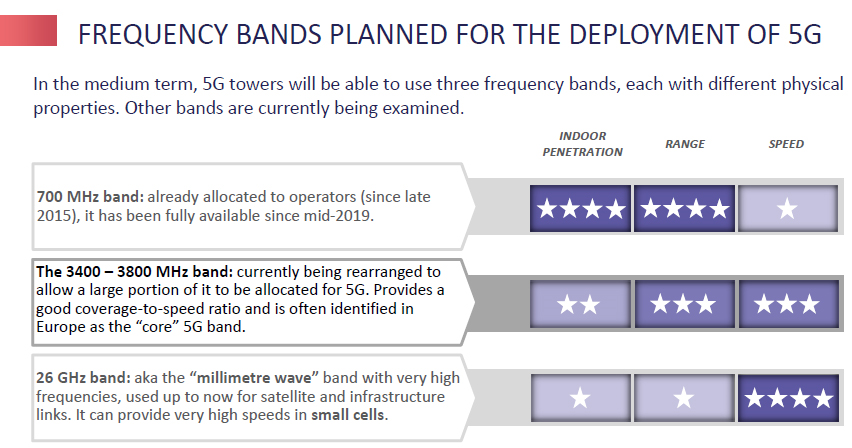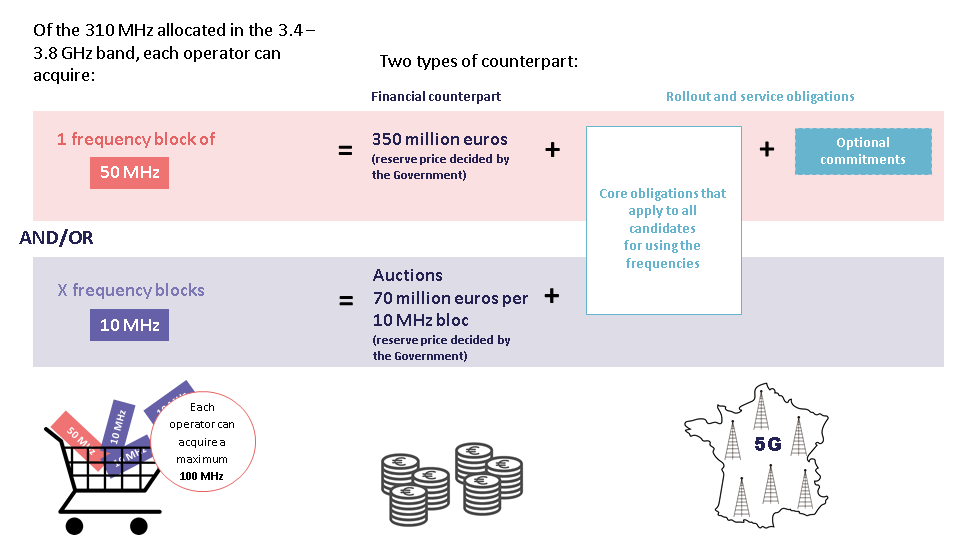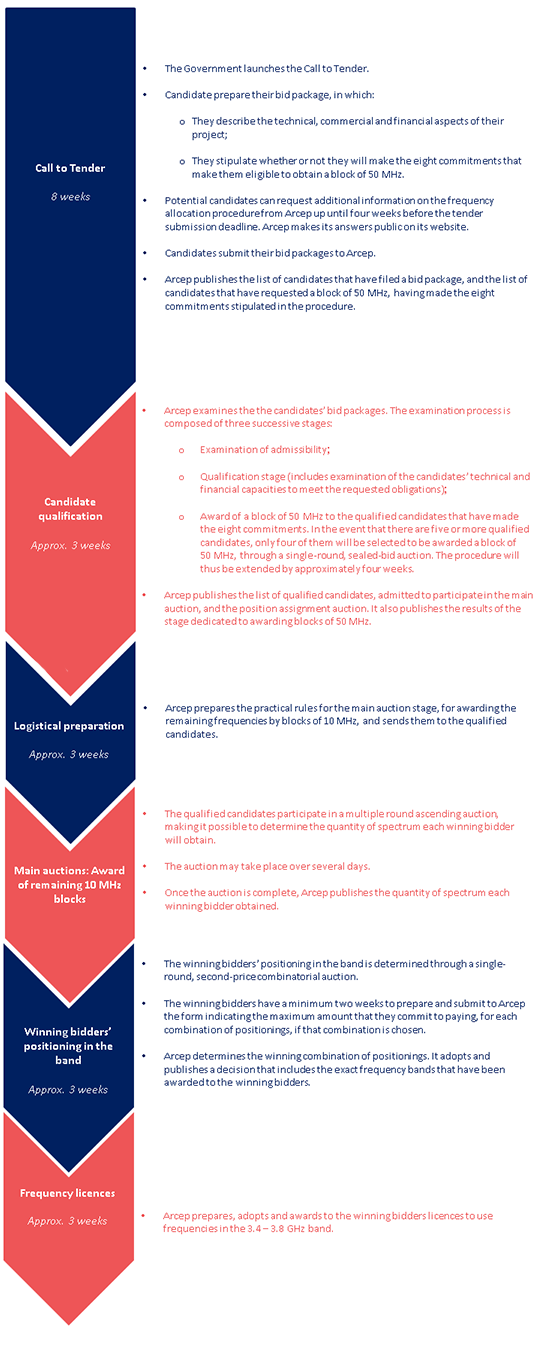The call to tender for awarding licences to use frequencies in the 3.4 – 3.8 GHz band, along with the Government Order launching the award procedure were published today in the Journal Officiel.
Players are invited to submit their bid package to Arcep before 12:00 pm on February 25th 2020.
Any requests for additional information on the procedure must be sent to Arcep before January 28th January 2020.
Arcep plans on then conducting the allocation procedure and awarding the frequency licences to the winning candidates in the first half of 2020.
Associated documents
Procedure and conditions for the allocation of “core” 5G (3.4 – 3.8 GHz band) frequencies
1. The 3.4 – 3.8 GHz band: the “core” 5G band in Europe
In 2016 the European Commission launched an action plan that was designed to set a common timetable across Europe for the coordinated commercial launch of 5G in 2020. In 2017, the European Union’s Estonian President proposed a 5G roadmap, which was co-signed by each Member State’s minister for electronic communications. The roadmap’s targets include 5G coverage of at least one major city in each Member State in 2020, and of all the main urban areas and transport corridors by 2025. In France, the Government, in concert with Arcep, presented the national roadmap for 5G on 16 July 2018. Arcep unveiled its 5G battle plan at the same time. Below is a list of the most recent stages in that work programme:

Several bands were identified in a coordinated fashion in Europe for future 5G rollouts. The Arcep specifications being submitted today to the Government concerns 3.4 – 3.8 GHz band frequency allocations – identified in Europe as the “core” 5G band. Thanks to a combination of its physical properties and the amount of spectrum available, this band provides a good trade-off between coverage and speed. Use of this core band will be completed by other bands of varying properties, each of which will help unleash the full potential of 5G. These include the 700 MHz band, which was already allocated to operators in France in 2015, and the 26 GHz band which will be allocated at a later date.

Work is still underway in Europe on setting all of the technical conditions for the 26 GHz band. Without waiting for that to be complete, in January 2019 Arcep and the Government issued a call for the creation of 5G trial platforms. Their aim was to galvanise stakeholders around the possibilities opened up by this frequency band, and to identify new uses it will enable. Eleven trial platforms have already been chosen, and were unveiled in October 2019.
The European Electronic Communications Code, which was adopted in late 2018, stipulates a coordinated timetable so that the core frequency bands are allocated in every Member State by the end of 2020. Other European countries have thus performed these allocations, in varying quantities. France is preparing to allocate a significant amount of spectrum: 310 MHz in the 3.4 – 3.8 GHz band.
2. Allocation procedure objectives
In the letter it sent to Arcep on 2 May 2019, the Government detailed the objectives for the regulator to pursue when drafting its specifications for 3.4 – 3.8 GHz band allocations:
- regional development: in addition to offloading mobile networks in the most densely populated parts of the country, the development of 5G services must benefit every region;
- competition: the procedure must allow at least four operators to be capable of providing 5G services under good conditions, while also having the ability to distinguish themselves from the competition;
- innovation and services for “vertical” sectors: no frequency will be reserved for vertical sectors, a priori, but one objective is to provide them with services that take their particular needs into consideration, regardless of their location;
- revenue: the procedure will include a financial criterion, with a reserve price of 2.17 billion euros for all of the frequencies allocated.
3. Allocation procedure
The allocation procedure has been established for 310 MHz of frequencies, covering Metropolitan France.. This will help determine the winners, the amount of spectrum awarded to each and their precise position on the band. All of the winners will be subject to obligations (see Part 4).
This will be a mixed allocation mechanism that is not based solely on financial bids. The procedure will include a first part whereby up to four operators will be able to obtain additional blocks of spectrum in exchange for additional commitments, before the auctions carried out in the second part allow them to obtain additional frequencies.

3.1 First part: Optional commitments in exchange for blocks of frequency
Arcep is giving applicants the option of making a series of commitments when submitting their application. If they do make these commitments, they will be written into the obligations attached the frequency licences that are awarded to the winning candidates, and come to supplement the obligations that will apply to all of the winners. The commitments and obligations are described in Part 4.
If four or fewer candidates agree to make these commitments when filing their application, each will be able to obtain a block of 50 MHz of spectrum for 350 million euros. If their number is equal to or over five, the applicants will bid for the four blocks in a separate auction.
3.2 Second part: Auction enabling each operator to acquire additional frequencies
The auction will then be held to allocate the frequencies that are still available after the first round of commitment-based spectrum awards. The qualified applicants, regardless of whether or not they obtain a block in the previous phase, will thus have the possibility of acquiring additional frequencies, divided by 10 MHz block. The initial price set for the first block of 10 MHz is set at 70 million euros, after which Arcep will conduct this multi-round auction as follows.
During each round, Arcep indicates the price of one 10 MHz block. Each applicant then indicates the number of blocks they want at that price. As long as the number of blocks requested by the operators is greater than the number of available blocks, Arcep will hold a new round and increase the unit price of each 10 MHz block, by previously established increments. The auction ends when operators’ demand matches the number of blocks available. All of the 10 MHz blocks will then be allocated at the final price bid. In a situation where the number of available blocks exceeds operators’ demand, a mechanism is in place for deciding between the last applicants to have withdrawn from the bidding.
Once the amount of spectrum allocated to each winner is known, there are multiple combinations for positioning them on the band. A new (single-round, second highest bid) auction will be held to determine each of the winners’ positions. They will thus have an opportunity to express their preferences on position on the band, and their position with respect to the other winners.
LESSONS LEARNED FROM OTHER ALLOCATIONS Arcep has already held auctions for allocating new frequencies, notably in the 800 MHz and 2.6 GHz bands (sealed bid auction in 2011) and in the 700 MHz band (multi-round auction in 2015). The mechanism being proposed today takes a combined approach: the procedure will begin with a commitment stage that allows applicants to obtain a first quantity of spectrum, before the multi-round auction is held, which provides applicants with a clear view of the amount of spectrum they can obtain, at each round. Arcep’s teams invited their fellow European telecoms regulators to provide feedback on France’s planned allocation procedure for 3.5 GHz band frequencies, in an unprecedented peer review process that was held on 5 September 2019. |
3.3 Capping the amount of spectrum available per applicant
A cap will be set on the total amount of spectrum any one applicant can obtain (during both phases of the procedure):
- A minimum of 40 MHz;
- A maximum of 100 MHz.
4. Obligations and commitments
4.1 Obligations that apply to all operators
The specifications submitted by Arcep include a set obligations that apply to all of the successful candidates:
- 5G deployment in the 3.4 – 3.8 GHz band
The specifications stipulate that each operator must launch 5G services in at least two cities before the end of 2020, then imposes a demanding trajectoryto support the deployment of 3.4 – 3.8 GHz band equipment during the following years:
- 3,000 sites in 2022,
- 8,000 sites in 2024,
- 10,500 sites in 2025.
Eventually, all of the cell sites must be providing a 5G service using frequencies in the 3.4 – 3.8 GHz band or other bands.
Arcep is also planning to introduce a concomitance mechanism to ensure that non-urban areas will also benefit from these rollouts. As a result, 25% of 3.4-3.8 GHz band sites in the last two stages must be located in sparsely populated areas, targeting economic activity, notably manufacturing, excluding major metropolitan areas. [1]
- Increasingly ubiquitous 5G punctuated by steadily increasing speeds
To set the pace for this rollout, Arcep also plans on keeping pace with growing bandwidth needs. By 2022, at least 75% of cell sites must be capable of providing speeds of at least 240 Mbit/s at each site. This obligation will be gradually applied to all cell cites, up to 2030.
- Roadway coverage
Obligations that apply specifically to transport corridors have two main milestones: coverage of the country’s motorways (16,642 km) by 2025 then, by 2027, coverage of the main roadways (54,913 km). These obligations stipulate connection speeds of a minimum 100 Mbit/s at each cell site.
- Slicing
The new level of performance provided by 5G opens the way for innovative uses in a number of vertical industries. These verticals expect customised networks and products that meet their specific needs. To make this happen, Arcep is asking operators to activate the most innovative 5G functions – i.e. slicing, or the ability to deliver tiered services – by 2023 at the latest.
- IPv6-compatibility
Furthermore, to accelerate the transition to the IPv6 routing protocol, Arcep has planned for an obligation to make mobile networks IPv6-compatible.
4.2 Optional commitments
The specifications contain a set of optional commitments. A maximum four candidates that have each made all of the following commitments will be able to obtain blocks of 50 MHz of spectrum:
- 5G to foster competitiveness in other sectors of the French economy
To lay the groundwork for enterprises’ future connectivity, Arcep has established an unprecedented mechanism that would have operators commit to granting reasonable requests from economic actors (business, local authorities, administrations…)by providing them with customised solutions in terms of coverage and performance or, if the operator prefers, by assigning its frequencies locally.
- Indoor coverage
Arcep has also provided for commitments that seek to improve indoor coveragefor business and commercial purposes, and to facilitate coverage by multiple operators.
- Fixed access products
Commitments also concern the supply of dedicated fixed access products on mobile networks.
- Greater transparency
The commitments include increasing operators’ transparency, both on their rollout forecasts and service outages.
- Bolster innovation and competition
Lastly, commitments are proposed to improve MVNO hosting on operators’ 5G networks, in particular to stimulate innovation from all the sector’s players.
5. Licence duration and rendez-vous clause
The frequencies will be allocated for a period of 15 years. This duration will be extended by five years if the licence-holder agrees to the conditions attached to this extension.
In addition, two interim reviews are scheduled for 2023 and before 2028 to verify operators’ implementation of their obligations, along with market requirements, notably in the areas of mobile network coverage and quality of service. Obligations could be revised based on the findings of these reviews, after having reached an agreement with the licence-holder.
6. Allocation timetable and stages

[1] This area includes all of the municipalities that are part of priority rollout areas defined by Arcep Decision No. 2015‑0825 and existing “Territories of Industry” municipalities, located outside urban areas with a population of more than 50,000 people.
